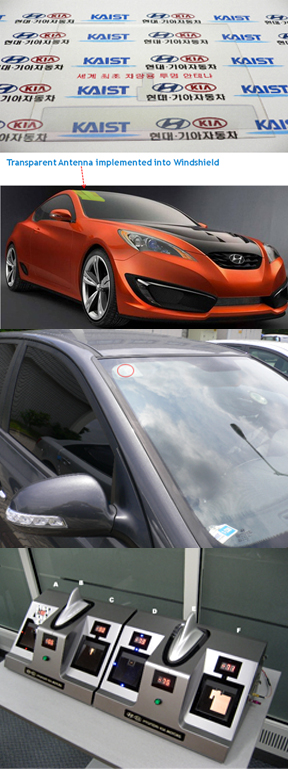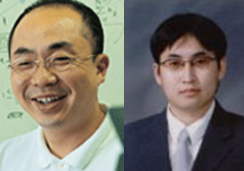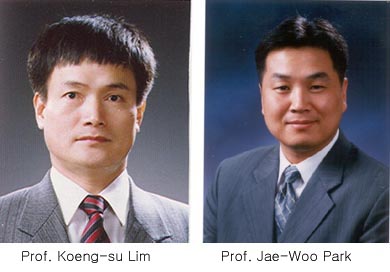School+of+Electric+Engineering
-
 Transparent Antenna for Automobile Developed
A research team led by Prof. Jae-Woo Park of the School of Electrical Engineering & Computer Science, KAIST, developed a transparent antenna for the next-generation automobiles, university authorities said on Monday (Aug. 17).
The development was made possible through joint researches with the Hyundai-Kia Automotive Group; Winncom, a car antenna manufacturer; and a group of researchers led by Han-Ki Kim of the Department of Display Materials Engineering at Kyung Hee University in Seoul.
The transparent antennas were developed in two kinds -- one for the HSDPA (High-Speed Downlink Packet Access), a new protocol for mobile telephone data transmission, and the other for transmitting and receiving radio wave for emergency call.
Using the transparent electrically conductive film formation technology, the transparent antennas are to be mounted on the windshield of a vehicle.
"The development of transparent antenna represents a step forward for the advancement of the next-generation automotive electronic technology," said Seong-woo Kim, a senior researcher at the Hyundai-Kia Group.
2009.08.18 View 14877
Transparent Antenna for Automobile Developed
A research team led by Prof. Jae-Woo Park of the School of Electrical Engineering & Computer Science, KAIST, developed a transparent antenna for the next-generation automobiles, university authorities said on Monday (Aug. 17).
The development was made possible through joint researches with the Hyundai-Kia Automotive Group; Winncom, a car antenna manufacturer; and a group of researchers led by Han-Ki Kim of the Department of Display Materials Engineering at Kyung Hee University in Seoul.
The transparent antennas were developed in two kinds -- one for the HSDPA (High-Speed Downlink Packet Access), a new protocol for mobile telephone data transmission, and the other for transmitting and receiving radio wave for emergency call.
Using the transparent electrically conductive film formation technology, the transparent antennas are to be mounted on the windshield of a vehicle.
"The development of transparent antenna represents a step forward for the advancement of the next-generation automotive electronic technology," said Seong-woo Kim, a senior researcher at the Hyundai-Kia Group.
2009.08.18 View 14877 -
 Prof. Chong Unveils New Human Movement Model
A KAIST research team headed by Prof. Song Chong of the School of Electrical Engineering and Computer Science has developed a new statistical model that simulates human mobility patterns, mimicking the way people move over the course of a day, a month or longer, university sources said on Tuesday (May 12).
The model, developed in collaboration with scientists at North Carolina State University, is the first to represent the regular movement patterns of humans using statistical data.
The model has a variety of potential uses, ranging from land use planning to public health studies on epidemic disease.
The researchers gave global positioning system (GPS) devices to approximately 100 volunteers at five locations in the U.S. and South Korea and tracked the participants" movements over time. By tracing the points where the study participants stopped, and their movement trajectories, researchers were able to determine patterns of mobility behavior.
The researchers were then able to emulate these fundamental statistical properties of human mobility into a model that could be used to represent the regular daily movement of humans. The model, called Self-similar Least Action Walk (SLAW), will have a wide array of practical applications.
The research, "SLAW: A Mobility Model for Human Walks," was presented on April 20 at the 28th IEEE Conference on Computer Communications in Rio de Janeiro, Brazil. The National Science Foundation of the U.S. funded the research.
2009.05.13 View 14929
Prof. Chong Unveils New Human Movement Model
A KAIST research team headed by Prof. Song Chong of the School of Electrical Engineering and Computer Science has developed a new statistical model that simulates human mobility patterns, mimicking the way people move over the course of a day, a month or longer, university sources said on Tuesday (May 12).
The model, developed in collaboration with scientists at North Carolina State University, is the first to represent the regular movement patterns of humans using statistical data.
The model has a variety of potential uses, ranging from land use planning to public health studies on epidemic disease.
The researchers gave global positioning system (GPS) devices to approximately 100 volunteers at five locations in the U.S. and South Korea and tracked the participants" movements over time. By tracing the points where the study participants stopped, and their movement trajectories, researchers were able to determine patterns of mobility behavior.
The researchers were then able to emulate these fundamental statistical properties of human mobility into a model that could be used to represent the regular daily movement of humans. The model, called Self-similar Least Action Walk (SLAW), will have a wide array of practical applications.
The research, "SLAW: A Mobility Model for Human Walks," was presented on April 20 at the 28th IEEE Conference on Computer Communications in Rio de Janeiro, Brazil. The National Science Foundation of the U.S. funded the research.
2009.05.13 View 14929 -
 Workshop on Biomedical IC to Be Held on March 26
KAIST will hold a workshop on "biomedical IC for future healthcare system" on March 26 at a lecture room of the School of Electrical Engineering & Computer Science. The workshop is organized by SEECS and the Korean Institute of Next Generation Computing.
At the workshop, a variety of new technologies expected to expedite the development of biomedical systems will be presented. KAIST Prof. Hoi-Jun Yoo will speak on the "body channel communication" using the human body as the signal transmission medium and Dr. Seung-Hwan Kim of Electronics and Telecommunications Research Institute (ETRI) on a wearable vital sign monitoring system.
Other subjects are CMOS (complementary metal-oxide semiconductor) fully electronic biosensor for biomolecular detection to be presented by KAIST Prof. Gyu-Hyeong Cho; nerve interface and IC (integrated circuit) system design by KAIST Prof. Yoon-gi Nam; design of neural recording and stimulation IC using time-varying magnetic field by KAIST Prof. Seong-Hwan Cho; low power multi-core digital signal processor for hearing aid by Dong-Wook Kim, senior researcher at the Samsung Advanced Institute of Technology; and a non-contact cardiac sensor by KAIST Prof. Seung-Chul Hong.
With the advent of the ageing society, medical expenses of the elderly people are rapidly increasing. As a way to address the issue, interests are growing in "ubiquitous healthcare," a technology that uses a large number of environmental and patient sensors and actuators to monitor and improve patients’ physical and mental condition.
The upcoming workshop is the first academic event on biomedical integrated chips to be held in Korea. The workshop will provide a valuable opportunity for experts in biomedical area to get together and examine the present status of Korean biomedical area and discuss about its future, KAIST officials said.
2009.03.20 View 19680
Workshop on Biomedical IC to Be Held on March 26
KAIST will hold a workshop on "biomedical IC for future healthcare system" on March 26 at a lecture room of the School of Electrical Engineering & Computer Science. The workshop is organized by SEECS and the Korean Institute of Next Generation Computing.
At the workshop, a variety of new technologies expected to expedite the development of biomedical systems will be presented. KAIST Prof. Hoi-Jun Yoo will speak on the "body channel communication" using the human body as the signal transmission medium and Dr. Seung-Hwan Kim of Electronics and Telecommunications Research Institute (ETRI) on a wearable vital sign monitoring system.
Other subjects are CMOS (complementary metal-oxide semiconductor) fully electronic biosensor for biomolecular detection to be presented by KAIST Prof. Gyu-Hyeong Cho; nerve interface and IC (integrated circuit) system design by KAIST Prof. Yoon-gi Nam; design of neural recording and stimulation IC using time-varying magnetic field by KAIST Prof. Seong-Hwan Cho; low power multi-core digital signal processor for hearing aid by Dong-Wook Kim, senior researcher at the Samsung Advanced Institute of Technology; and a non-contact cardiac sensor by KAIST Prof. Seung-Chul Hong.
With the advent of the ageing society, medical expenses of the elderly people are rapidly increasing. As a way to address the issue, interests are growing in "ubiquitous healthcare," a technology that uses a large number of environmental and patient sensors and actuators to monitor and improve patients’ physical and mental condition.
The upcoming workshop is the first academic event on biomedical integrated chips to be held in Korea. The workshop will provide a valuable opportunity for experts in biomedical area to get together and examine the present status of Korean biomedical area and discuss about its future, KAIST officials said.
2009.03.20 View 19680 -
 KAIST Scientists Creates Transparent Memory Chip
--See-Through Semis Could Revolutionize Displays
A group of KAIST scientists led by Prof. Jae-Woo Park and Koeng-Su Lim has created a working computer chip that is almost completely clear -- the first of its kind.
The new chip, called "transparent resistive random access memory (TRRAM), is similar in type to an existing technology known as complementary metal-oxide semiconductor (CMOS) memory -- common commercial chips that provide the data storage for USB flash drives and other devices. Like CMOS devices, the new chip provides "non-volatile" memory, meaning that it stores digital information without losing data when it is powered off. Unlike CMOS devices, however, the new TRRAM chip is almost completely clear.
The paper on the new technology, entitled "Transparent resistive random access memory and its characteristics for non-volatile resistive switching," was published in the December issue of the Applied Physics Letters (APL), and the American Institute of Physics, the publisher of APL, issued a press release about this breakthrough.
"It is a new milestone of transparent electronic systems," says researcher Jung-Won Seo, who is the first author of the paper. "By integrating TRRAM devices with other transparent electronic components, we can create a totally see-through embedded electronic system."
Technically, TRRAM devices rely upon an existing technology known as resistive random access memory (RRAM), which is already in commercial development for future electronic data storage devices. RRAM is built using metal oxide materials between equally transparent electrodes and substrates.
According to the research team, TRRAM devices are easy to fabricate and may be commercially available in just 3-4 years.
"We are sure that TRRAM will become one of alternative devices to current CMOS-based flash memory in the near future after its reliability is proven and once any manufacturing issues are solved," says Prof. Jae-Woo Park, who is the co-author on the paper. He adds that the new devices have the potential to be manufactured cheaply because any transparent materials can be utilized as substrate and electrode. They also may not require incorporating rare elements such as Indium.
2008.12.17 View 18169
KAIST Scientists Creates Transparent Memory Chip
--See-Through Semis Could Revolutionize Displays
A group of KAIST scientists led by Prof. Jae-Woo Park and Koeng-Su Lim has created a working computer chip that is almost completely clear -- the first of its kind.
The new chip, called "transparent resistive random access memory (TRRAM), is similar in type to an existing technology known as complementary metal-oxide semiconductor (CMOS) memory -- common commercial chips that provide the data storage for USB flash drives and other devices. Like CMOS devices, the new chip provides "non-volatile" memory, meaning that it stores digital information without losing data when it is powered off. Unlike CMOS devices, however, the new TRRAM chip is almost completely clear.
The paper on the new technology, entitled "Transparent resistive random access memory and its characteristics for non-volatile resistive switching," was published in the December issue of the Applied Physics Letters (APL), and the American Institute of Physics, the publisher of APL, issued a press release about this breakthrough.
"It is a new milestone of transparent electronic systems," says researcher Jung-Won Seo, who is the first author of the paper. "By integrating TRRAM devices with other transparent electronic components, we can create a totally see-through embedded electronic system."
Technically, TRRAM devices rely upon an existing technology known as resistive random access memory (RRAM), which is already in commercial development for future electronic data storage devices. RRAM is built using metal oxide materials between equally transparent electrodes and substrates.
According to the research team, TRRAM devices are easy to fabricate and may be commercially available in just 3-4 years.
"We are sure that TRRAM will become one of alternative devices to current CMOS-based flash memory in the near future after its reliability is proven and once any manufacturing issues are solved," says Prof. Jae-Woo Park, who is the co-author on the paper. He adds that the new devices have the potential to be manufactured cheaply because any transparent materials can be utilized as substrate and electrode. They also may not require incorporating rare elements such as Indium.
2008.12.17 View 18169